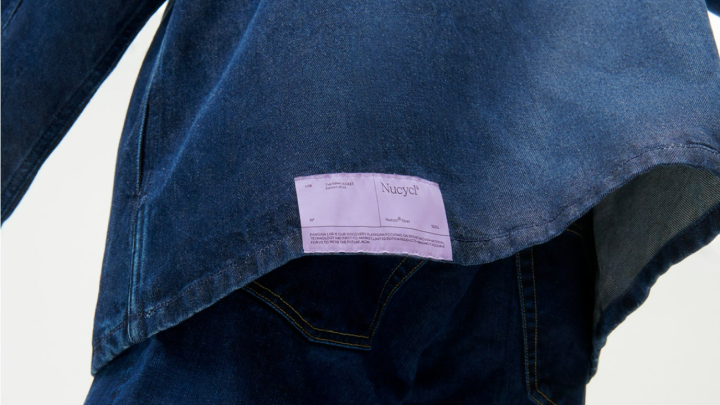Material circularity is on the rise and the latest company to produce a completely recyclable piece of clothing is sustainable apparel brand Pangaia. Textiles innovation company Evrnu was a partner in the effort. Together, the B Corp certified organisations have created the first denim jacket made from cotton textile waste. The RENU jacket is inspired by the classic jean jacket and has been developed using Evrnu’s NuCycl technology, which turns fabric scraps, deadstock materials and old
ld clothing into new fibres ready to be made into garments. This process produces stronger cellulosic fibres that can be recycled up to five times while maintaining performance quality.
This innovative collaboration is part of Pangaia Lab, a designated home for experimenting with material technology to create limited-edition products and reduce the barriers between people and materials science. The 20 RENU jackets show that alternative fibres can be used in denim making.
“Evrnu represents the very best of innovation in the space of recycled fibers. We have been on a long journey together as partners, and we are delighted to be bringing out our first product together, demonstrating the extraordinary potential for superior quality from recycling technologies,” says Dr Amanda Parkes, chief innovation officer at Pangaia.
Evrnu’s NuCycl technology does not blend old threads with any virgin fibre, prevents greenhouse gases, and extends the life cycle of raw materials by multiple times. Textile waste is disassembled to the molecular level and regenerated into new clothing, home and industrial textiles.
Stacy Flynn, Evrnu’s CEO and co-founder said, “We are thrilled to partner with Pangaia, which shares our drive to unlock the future of materials and technology for the fashion industry. Our mission is to help brands create clothing out of recycled materials that are not only of the highest quality but can also continue to be recycled. We are delighted by the growing market demand for NuCycl.”
Pangaia has previously collaborated with protein-based materials innovator Spiber to create the world’s first bio-fabricated hoodie made from a fermentation process that uses sugars and microbes. The company has also teamed with Colorifix, a leader in developing a dyeing process that uses bacteria to help the textile industry reduce its environmental impact.
It’s critical for the fashion industry to integrate more sustainable methods of sourcing textiles and raw materials into their supply chain. The aim is to reduce the tonnes of textile waste being buried and burned, which has a detrimental impact on the environment.
Swamped in textile waste
Last year, Earth.org reported 92 million tonnes of textile waste is produced every year. This is equivalent to a rubbish truck full of clothes dumped in landfill sites every second. The impact this has on the planet is diabolical and it is not just a consumer problem, it is the responsibility of everyone in the fashion and textiles industry.
Hyper-consumerism is at a record high, fueled by social media trends and fast fashion, which produce thousands of new styles a week. The entire fashion supply chain is at a breaking point. It is imperative that alternative ways to source fibres start now and evolve past beyond brands rolling out take-back schemes. There’s no way of knowing exactly what happens to clothes in those schemes, and true circularity supports reducing our consumption, reusing existing products, and recycling products to be made into new materials.
Unless accountability and reliable traceability improve, the textile waste problem will increase from 92 million tonnes to 134 million tonnes a year by 2030. Causing the apparel industry’s global emissions to increase by 50 percent.
Change can’t wait
Sustainability and circular fashion are easier said than done. However, the tea leaves have a smokey flavour and what they’re trying to tell you is the planet is burning. If businesses leave it to the next generation of brands and designers to build circularity into their processes, the problem will undoubtedly be more difficult to fix.
The industry must consider exploring material sciences, regenerative farming, and innovative solutions that leave out petrochemical or animal-derived raw materials. Build a partner network of textile recyclers and pre-loved clothing platforms that make it easy for customers to list items. Then back it up by integrating with technologies that enable brands to communicate and visualise the transparency of supply chains from cradle to grave.
In Australia, there are multiple organisations that can assist brands in advancing their sustainability efforts. From Upparel, Textile Recyclers Australia and BlockTexx, to Ethical Clothing Australia, Circular Centre Australia, The Woolmark Company, and Cotton Australia.
Designer Kit Willow prioritises consciously sourcing materials that minimise environmental impact and has adopted three pillars within the business to support circularity. ‘Rewild’ by sourcing material from farmers practising regenerative agriculture, ‘renew’ materials to generate products from waste, and ‘rehome’ past KitX collections and educate customers on how best to care for their garments and extend their life.
Pangaia is an industry leader that has crafted an innovative way to produce sustainable products in small batches with Pangaia Lab. It has partnered with solution providers who are working tirelessly to help the industry change its ways.
There is no excuse not to take action. Even small changes will greatly improve the environment and put into practice healthy fashion habits for customers and the industry.
Where do you see the fashion industry in 2030 and what part will you play?

